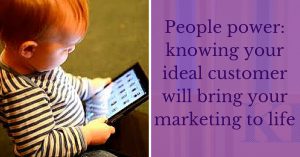When I first started my business I read everything I could get my hands on that could teach me the new skills I would need to reach potential customers. I’m still reading, but over time I’ve worked out where my time is best spent. Even though I write marketing content I’m constantly learning about marketing strategy and if there’s one lesson that I hear time and time again it’s this:
KNOW YOUR CUSTOMER!
Even if you think your product or service could be for anyone, it couldn’t.
Find your niche
I know, niching is counterintuitive. I still struggle with it even though I know I need to do it. You worry about missing someone, especially during the early days when you may not have regular customers and money is still tight.
The point is, all of the people who are most likely to buy from you will have something in common, or even a range of things. That doesn’t mean they’ll all be the same. If you offer financial planning and wills you could be dealing with millionaires one day and a pensioner who wants to make sure her children will inherit the house the next.
How defined your niche is depends on you and your business. I work primarily with small business owners who don’t have time to write their own blog or need some eye-catching copy for their website. It doesn’t matter where they are geographically but a lot of them are in a similar age bracket and they often have children. I’m also noticing a general fondness for wine amongst my female clients!
You might need to think about where your customers are if you have physical premises they’ll need to visit. Your product might be aimed exclusively at women or require a certain level of income if you have a luxury brand.
Build a persona
Who are your existing customers? Think about the ones who come back time and time again and are always happy. Then consider who else you want to attract and start to create customer personas.
A persona, also known as an avatar, is a profile of your ideal customer. Be as specific as you possibly can. You’re not limited to one so create each persona as if they’re a real person standing in front of you. Think about how old they are, whether they’re male or female and what their interests are. I’ve seen examples that describe the types of bars the person visits or whether they prefer to invite friends round for dinner at home. Some even give specific examples of the mobile phone their prospects will use.
Where is your customer?
When you create your personas, you’ll find that a person’s interests will define what they read, watch and what social media they use. Getting clear on that will really help you in the long run.
Your marketing message
No matter what marketing techniques you use, your knowledge of your customer should be the starting point. Knowing where to find them will help you to decide where your message should be.
It should also help you to work out what to say, but that’s a whole blog post in itself. Most importantly, it will tell you what tone of voice to use. After all, you don’t speak to your bank manager in the same way as you do to your friends on a night out. At least, I hope you don’t.
If you need any help or want to try a new approach to your content marketing, I’m for hire! Get in touch or register here to receive regular updates, special offers and a free copy of my guide, ‘Marketing magic: your indispensable guide to creating amazing headlines’.
